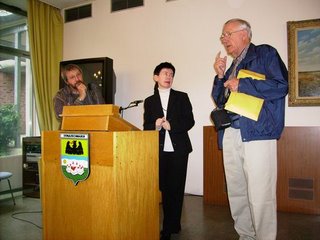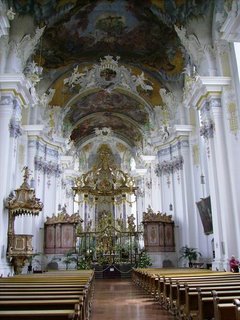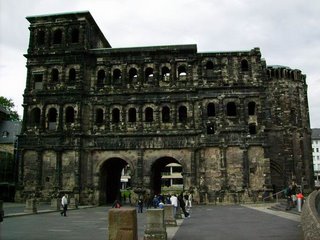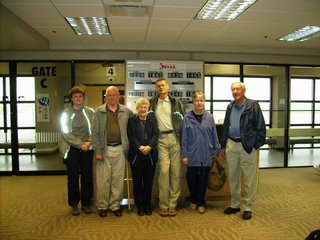Today was a remarkable day, especially for Jim Griffin. He was pretty tickled yesterday when we toured St. Paulin church in Trier. His research has revealed that the Bolen name that he is searching evolved from the French Paulin. In Trier he found that St. Paulin was very revered in an area not too far from his ancestors’ stomping grounds.

We drove a couple of hours south to Metz and stopped to tour a bit around St. Etienne cathedral. A 15 minute stop turned into an hour as a couple of us tried to cash travellers’ cheques at a bank that wasn’t too familiar with them.
From Metz we drove southeast to the group of villages in which Jim was interested. The cemetery was half way between two villages, Voimhaut and Vittoncourt, on his list. When we stopped, we asked a local how old the cemetery was. He said that this was the newer cemetery and that the old one, with the time period that Jim wanted, was in the next town. We drove on (they were only a mile or two apart) and all piled out to investigate the cemetery. Not finding anything of onterest, we were just about to leave when Helmut, our driver, asked a lady about the

Paulin family. She said there are none here any more, but there is a fairly new family plot. We drove back and, sure enough, there was a whole family of Paulins from the last couple of decades.
We drove back to Vittoncourt for a picnic lunch of groceries that we had picked up when it looked like the sun was coming out and the weather was warming. Unfortunately, it was a trick and we had a pretty cool lunch of local meats, cheeses, and baguettes.
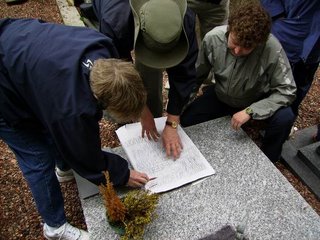
After lunch, we drove on to the next village on Jim’s list, Hollacourt, a tiny village of not much more than a dozen houses. We almost missed the church, which did not look like a church at all, and only found it because a couple of headstones were poking up above the surrounding fence. Jim hopped out by himself for a quick look around while the rest of us stayed behind to keep warm. Suddenly, he started scurrying around in a frenzy. He had found a small plaque that had come off an old grave stone. On the plaque was the tombstone data for one of the people for whom he had been searching. A couple of the ladies grabbed the roll of paper tablecloth, and soon we were they were making a rubbing of the stone.

Meanwhile, one of the locals wandered over to check out what all the fuss was about. I feel pretty safe in saying that this town had never before seen a tour bus of any description, so we were quite a curiosity. When we told him what we were up to, he said that he was a keen genealogist himself and that he had genealogical information on the whole town in his office – the mayor’s office, that is. Soon he was making copies confirming and expanding Jim’s research. He and Jim exchanged addresses and the mayor promised to send Jim copies of all the original documents that he could find in the town records. That's Jim in the middle with the Mayor on the right. The one on the left is just some guy who wanted his picture taken.

With Jim grinning from ear to ear and floating so high that we had to hold him down, we went on the third village, which did not produce any new discoveries. At the fourth village, Mainvillers, Jim and I unsuccessfully scouted the cemetery outside of town. We almost drove past the church before somebody noticed that there were some headstones right beside it. Again Jim jumped out to investigate while the rest of us stayed snuggly inside. Suddenly he again began to scribble furiously. We all jumped out to join him and found that he had discovered another tombstone that took his search one step farther back to another village. This stone was more of a monument than a headstone and it was built right into the side of the church. With another rubbing in hand, we were finally off to Pforzheim with the rest of us all wondering if we would experience similar luck.
We arrive in Pforzheim at 5:30 pm. We had two items on the agenda: to hook up with Daryle Niedermayer who was to arrive in Frankfurt today and meet us at the hotel after a train ride; and to contact Herr Georg Kurzhals, who had been so generous to our group when we were getting started. Herr Kurzhals has not been in the best of health, so we were going to telephone him, see ho he was doing, and make a plan from there.

On arrival we were met by Daryle, who had arrived an hour previously. He informed us that he was having coffee with Herr Kurzhals, who had been there waiting for us since 1 pm. We all went for supper and took turns crowding around Herr Kurzhals who, at age 94, personally experienced many of the aspects of life in Zichydorf that we had only heard about. Despite a weak voice and halting speech, Herr Kurzhals was clearly happy that all these people from so far away were taking an interest in the thing closest to his heart – his home village. We finally took him home at 9:30. He was clearly tired, but very happy.
The scenery is just beautiful. Rolling hills green with bluffs of trees and ripening crops. Picturesque villages nestled in shallow valleys by creeks and small rivers. Almost every view is postcard perfect.
 We watched as the ambulance took him away at about 8 a.m. and decided to kill some time by going to a nearby mall for some breakfast. We gathered Helmut’s possessions, loaded them onto the bus, and planned to be back by 10 to see how things worked out.
We watched as the ambulance took him away at about 8 a.m. and decided to kill some time by going to a nearby mall for some breakfast. We gathered Helmut’s possessions, loaded them onto the bus, and planned to be back by 10 to see how things worked out.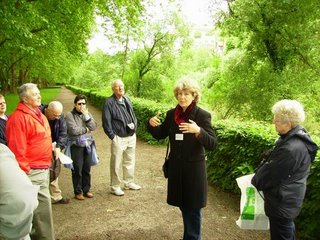 With Helmut back at the helm, we were off to Tuebingen for a guided tour of the old university town, constructed tin 1477 and still in use. Our guide was Elisabeth Tielsch.
With Helmut back at the helm, we were off to Tuebingen for a guided tour of the old university town, constructed tin 1477 and still in use. Our guide was Elisabeth Tielsch.


